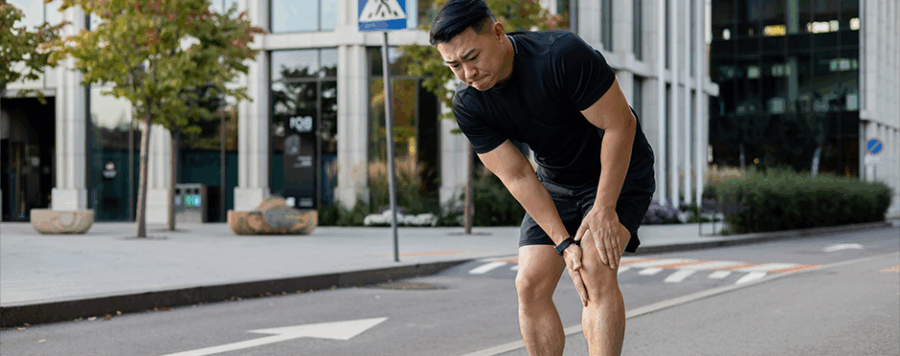Oftentimes when runners are eager to get outdoors and back into their routine after taking some time off or focusing on indoor runs, they jump right back into activity rather than slowly easing in and thus are more susceptible to injuries, including patellofemoral syndrome, which is often referred to as “runner’s knee.”
Patellofemoral syndrome is one of the most common types of knee pain seen in the outpatient setting. It is caused by imbalances in the forces that control the tracking of the patella (kneecap). Forces on the patellofemoral joint range from one-third to one-half of body weight during walking, three times body weight with stair climbing, five to siz times body weight with running, and up to seven times body weight with squatting.
Risk Factors for Developing Patellofemoral Syndrome:
- Overuse
- Trauma
- Tight quadriceps, iliotibial band, and connective tissue called the lateral retinaculum
- Poor quadriceps strength
- Lack of flexibility
- Weakness of hip
- Excessively worn or inappropriate footwear
- Resuming running after periods of inactivity
- Progressing distance too quickly
Typical Symptoms of Patellofemoral Syndrome:
- Pain behind or around the patella (kneecap) with activities like stair climbing, squatting, running
- Stiffness or pain following prolonged sitting with the knees bent
Management of patellofemoral syndrome should include relative rest and a comprehensive rehabilitation program to address the underlying causes. In the early stages of rehabilitation, activities that cause loading of the patellofemoral joint should be temporarily avoided or decreased to a level that does not elicit pain during or within 24 hours after the activity. This includes decreasing distance and frequency of running and eliminating strength training activities that stress the joint such as squats, lunges, or resisted knee extensions. Alternative forms of exercise including swimming, biking, and elliptical trainer can be utilized to maintain fitness while undergoing treatment.
Physical therapy is also an important component in the treatment of patellofemoral syndrome to identify underlying causes and restore function. A physical therapist will identify the specific factors causing symptoms, and design an individualized program. Treatment will look different for each person as the underlying causes may be different, but some common elements of treatment include:
- Flexibility exercises for the hamstrings, quadriceps, and iliotibial bands
- Quadriceps and gluteal strengthening
- Soft-tissue and joint mobilization
- Balance and proprioceptive (body’s awareness of where it is in space) activities
- Retraining of lower extremity biomechanics
- Education in a return-to-run program
If you have been experiencing symptoms of patellofemoral syndrome, contact your nearest Athletico today to connect with one of our movement experts who can help!
*Per federal guidelines, beneficiaries of plans such as Medicare, Medicaid, Tricare, VHA and other federally funded plans are not eligible for free assessments.
The Athletico blog is an educational resource written by Athletico employees. Athletico bloggers are licensed professionals who abide by the code of ethics outlined by their respective professional associations. The content published in blog posts represents the opinion of the individual author based on their expertise and experience. The content provided in this blog is for informational purposes only, does not constitute medical advice and should not be relied on for making personal health decisions.

 width="900"
height="356"
>
width="900"
height="356"
>

2 Comments
carlos
Hello I was diagnosed with patellofemoral pain on both knees. Is there any exercises to train around the injury besides the ones my doctor gave me . Maybe box squats ? Since those take pressure off the knees. Yesterday I tried doing some leg exercises at the gym I felt no pain during the exercises but the next day I felt some fluid inflammation in both knees. No pain just discomfort. Can I continue to do leg exercises or will it make it worse or better if no pain is there ? Thanks alot
Max Heredia
Seems that this condition is common especially in young athletes. What is the typical recovery time on a healthy young athlete, assuming he/she is doing proper rest and recovery?